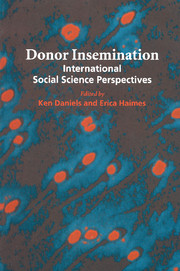Book contents
- Frontmatter
- Contents
- List of figures
- List of tables
- Notes on contributors
- Acknowledgements
- List of abbreviations
- 1 International social science perspectives on donor insemination: an introduction
- 2 The users of donor insemination
- 3 Families created through donor insemination
- 4 The making of ‘the DI child’: changing representations of people conceived through donor insemination
- 5 The semen providers
- 6 The medical management of donor insemination
- 7 Regulation of donor insemination
- 8 Donor insemination and ‘public opinion’
- 9 Concluding comments
- Index
1 - International social science perspectives on donor insemination: an introduction
Published online by Cambridge University Press: 04 August 2010
- Frontmatter
- Contents
- List of figures
- List of tables
- Notes on contributors
- Acknowledgements
- List of abbreviations
- 1 International social science perspectives on donor insemination: an introduction
- 2 The users of donor insemination
- 3 Families created through donor insemination
- 4 The making of ‘the DI child’: changing representations of people conceived through donor insemination
- 5 The semen providers
- 6 The medical management of donor insemination
- 7 Regulation of donor insemination
- 8 Donor insemination and ‘public opinion’
- 9 Concluding comments
- Index
Summary
In this book we aim to present the first systematic social science analysis of donor insemination (DI): the process through which a (usually anonymous) fertile man provides semen (most often with the assistance of medical personnel) to a fertile women in order to help her try to conceive a child. The major indication for the use of DI is that the female does not have a fully fertile male partner. We also aim to locate this practice in its global setting. In pursuing these aims we shall be both documenting, and contributing to, the debates on practice and policy around DI that have emerged in the latter half of the twentieth century and that promise to shape the social identity of DI in the first part of the next century.
It is especially appropriate to tackle this task now since donor insemination has been practised for just over 100 years (the first successful case occurred in 1884) and is the oldest technique in ‘the new technologies of reproduction’. DI has remained hidden from public view and scrutiny for much of that time, only emerging fully on to the public agenda with the development, in the 1970s and 1980s, of other related technologies of reproduction, such as in vitro fertilisation and egg donation. There are numerous strands to the historical development, and current social context of DI, both as a medical technique and as a solution to the problem of infertility: these require identification and disentangling.
- Type
- Chapter
- Information
- Donor InseminationInternational Social Science Perspectives, pp. 1 - 6Publisher: Cambridge University PressPrint publication year: 1998
- 7
- Cited by



